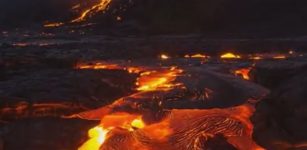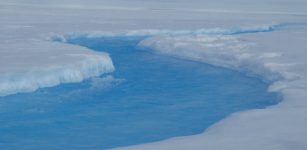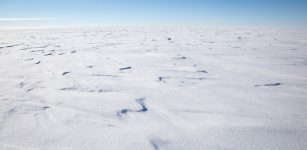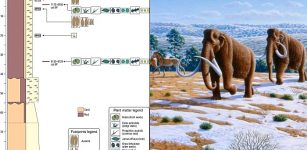Study Reveals More Hostile Conditions On Earth As Life Evolved
Eddie Gonzales Jr. – MessageToEagle.com – During long portions of the past 2.4 billion years, the Earth may have been more inhospitable to life than scientists previously thought, according to new computer simulations.
Using a state-of-the-art climate model, researchers now believe the level of ultraviolet (UV) radiation reaching the Earth’s surface could have been underestimated, with UV levels being up to ten times higher.
Graphic showing how UV radiation on Earth has changed over the last 2.4 billion years. Credit: Please credit: Gregory Cooke/ Royal Society Open Science
UV radiation is emitted by the sun and can damage and destroy biologically important molecules such as proteins.
The last 2.4 billion years represents an important chapter in the development of the biosphere. Oxygen levels rose from almost zero to significant amounts in the atmosphere, with concentrations fluctuating but eventually reaching modern day concentrations approximately 400 million years ago.
During this time, more complex multicellular organisms and animals began to colonize land.
Gregory Cooke, a Ph.D. researcher at the University of Leeds who led the study, said the findings raise new questions about the evolutionary impact of UV radiation as many forms of life are known to be negatively affected by intense doses of UV radiation.
He said: “We know that UV radiation can have disastrous effects if life is exposed to too much. For example, it can cause skin cancer in humans. Some organisms have effective defense mechanisms, and many can repair some of the damage UV radiation causes.
“Whilst elevated amounts of UV radiation would not prevent life’s emergence or evolution, it could have acted as a selection pressure, with organisms better able to cope with greater amounts of UV radiation receiving an advantage.”
The research “A revised lower estimate of ozone columns during Earth’s oxygenated history” is published in the scientific journal Royal Society Open Science.
The amount of UV radiation reaching the Earth is limited by the ozone in the atmosphere, described by the researchers as “…one of the most important molecules for life” because of its role in absorbing UV radiation as it passes into the Earth’s atmosphere.
Ozone forms as a result of sunlight and chemical reactions—and its concentration is dependent on the level of oxygen in the atmosphere.
For the last 40 years, scientists have believed that the ozone layer was able to shield life from harmful UV radiation when the level of oxygen in the atmosphere reached about one percent relative to the present atmospheric level.
The new modeling challenges that assumption. It suggests the level of oxygen needed may have been much higher, perhaps 5% to 10% of present atmospheric levels.
As a result, there were periods when UV radiation levels at the Earth’s surface were much greater, and this could have been the case for most of the Earth’s history.
A rough outline of oxygen (O2) concentrations in Earth’s atmosphere through time are illustrated in this figure. Brown blocks show the estimated range for O2 in terms of its present atmospheric level (which is 21% by volume). Grey-blue lines indicated various important events for the evolution of life, including the emergence of eukaryotes and animals. Black arrows refer to important events where atmospheric oxygen concentration changed. The Archean, Proterozoic, and Phanerozoic are geological eons. GOE = Great Oxidation Event; NOE = Neoproterozoic Oxidation Event; CE = Cambrian Explosion; LE = Lomagundi Excursion. Credit: Please credit: Gregory Cooke/ Royal Society Open Science
Mr Cooke said: “If our modeling is indicative of atmospheric scenarios during Earth’s oxygenated history, then for over a billion years the Earth could have been bathed in UV radiation that was much more intense than previously believed.
“This may have had fascinating consequences for life’s evolution. It is not precisely known when animals emerged, or what conditions they encountered in the oceans or on land. However, depending on oxygen concentrations, animals and plants could have faced much harsher conditions than today’s world. We hope that the full evolutionary impact of our results can be explored in the future.”
The results will also lead to new predictions for exoplanet atmospheres. Exoplanets are planets that orbit other stars. The presence of certain gases, including oxygen and ozone, may indicate the possibility of extra-terrestrial life, and the results of this study will aid in the scientific understanding of surface conditions on other worlds.
Written by Eddie Gonzales Jr. – MessageToEagle.com Staff












